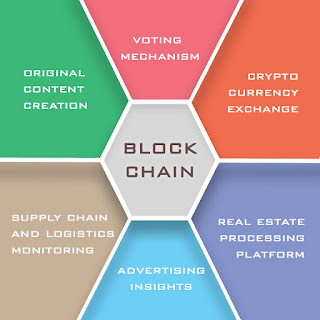Breaking Down Blockchain
 |
Have you ever thought about the Bitcoin, and wondered how it works?
Well, Blockchain is the recent technology which can be understood as a transparent ledger system over the Internet which emerged as a decentralized secure network. It controls how cryptocurrencies like Bitcoin, Ethereum etc. work. It also has various applications in other domains like the industrial sector, banking, supply chain management and so on. So, let’s dive in and explore Blockchain.
There are three main aspects of blockchain which essentially forms the basic pillars of this technology- Blocks, the Network and Mining.
Blocks mainly contain data comprising of information on various transactions, digital signatures and hashes associated with each block. In the crypto-currency domain, data mainly comprises of information on transactions like names of people sending and receiving currency, date and time of transaction etc.
Miners create new blocks on the chain through a process called mining. In a blockchain every block has its own hash (sequence of alphanumeric characters) and a unique nonce (a type of hash starting with consecutive number of zeros) and also references the hash of the previous block in the chain, so mining a block isn't easy, especially on large chains. Miners use computing power to solve the incredibly complex math problem of finding a nonce that generates an accepted hash. Because the nonce is only 32 bits and the hash is 256, there are roughly four billion possible nonce-hash combinations that must be mined before the right one is found.
When that happens, miners are said to have found the "golden nonce" and their block is added to the chain. Making a change to any block earlier in the chain requires re-mining not just the block with the change, but all of the blocks that come after. This is why it's extremely difficult to manipulate blockchain technology.
The network is decentralized, which means no single computer or organization can own the chain for itself. It acts as a distributed ledger which is accessible to all the people in the network. Nodes of the network can be any kind of electronic device that maintains copies of the blockchain and keeps the network functioning.
 |
| Photo Source |
With this basic understanding of how blockchain works, now let’s see what are the types of blockchain variants.
- Public blockchains
- Private blockchains
- Hybrid blockchains
- Sidechains
These are few variants of blockchain which are differentiated based on accessibility of data and the privileges associated with different users in the network . Now we will look into the various applications of blockchain which has proved to be a boon in the industrial and business sectors.
Blockchain provides a way to securely and efficiently create a tamper-proof log of sensitive activity. This makes it excellent for international payments and money transfers.
For example, in April 2018, Banco Santander launched the world's first blockchain-based money transfer service. Known as "Santander One Pay FX," the service uses Ripple's x-Current to enable customers to make same-day or next-day international money transfers.
Capital Markets:
Blockchain-based systems also have the potential to improve capital markets. A McKinsey report identifies benefits that blockchain solutions offer capital markets, some of which include:
- Faster clearing and settlement
- Consolidated audit trail
- Operational improvements
Insurance:
Arguably the greatest blockchain application for insurance is through smart contracts. These contracts allow customers and insurers to manage claims in a transparent and secure manner. All contracts and claims can be recorded on the blockchain and validated by the network, which would eliminate invalid claims, since the blockchain would reject multiple claims on the same accident.
Though block chain is introduced for the purpose of crypto currency, it has nearly endless number of applications across almost every industry.
As Fred Ehrsam, co-founder of Coinbase (Coinbase is a digital currency exchange) quotes,
“Everything will be tokenized and connected by a blockchain one day”.
In the future blockchain will play a major role and it is also a requirement to bring business sector, industrial sector, banking etc under its network to ensure security, authenticity and transparency of the data.





Comments
Post a Comment